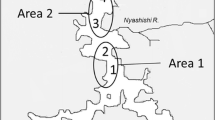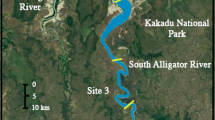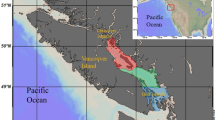Abstract
Basic ecological knowledge regarding the importance of different sources of primary production and how it is transferred among consumer species is required to properly manage and conserve subpolar ecosystems that are particularly vulnerable to environmental changes. We used carbon (δ13C) and nitrogen (δ15N) stable isotope analysis to establish a baseline of species interactions and food web structure for the nearshore marine community in Bahia Lapataia, Argentina, an ecosystem that faces many threats, including a recent invasion of exotic chinook salmon. Primary producers and other organic sources (e.g., particulate organic matter) available to the food web were isotopically distinct and had a wide range in δ13C (−31.3 to −5.3 ‰) and δ15N (−0.5 to 13.1 ‰) values. Consumers also showed a wide range of isotope values with mean δ13C and δ15N values ranging from −20.8 to −12.3 ‰ and from 10.5 to 19.6 ‰, respectively. A cluster analysis of these isotope data correctly identified functional groups and expected interactions among species based on independent information. Using Bayesian isotope mixing models, we estimated that the proportional contribution of benthic production, in particular through grazing and the consumption of detritus, was a more important source of energy for primary and secondary consumers than pelagic production. Using stable isotope analysis to continually monitor species interactions and food web structure may prove to be a valuable research and management tool for assessing ecological consequences of different threats in this and other subpolar ecosystems.




Similar content being viewed by others
References
Adami ML, Gordillo S (1999) Structure and dynamics of the biota associated with Macrocystis pyrifera (Phaeophyta) from the Beagle Channel, Tierra del Fuego. Sci Mar 63:183–191
Administración de Parques Nacionales (APN) (2012) Sistema de información de biodiversidad. www.sib.org.ar. Accessed Nov 22, 2012
Andrade C, Rios C (2007) Estudio experimental de los hábitos tróficos de Trophon geversianus (Pallas 1774) (Gastropoda: Muricidae): selección y manipulación de presas. An Inst Patagon 35:45–53
Arismendi I, Soto D (2012) Are salmon-derived nutrients being incorporated in food webs of invaded streams? Evidence from southern Chile. Knowl Manag Aquat Ecosyst 405:01
Bascompte J, Melian CJ, Sala E (2005) Interaction strength combinations and the overfishing of a marine food web. Proc Natl Acad Ssci USA 102:5443–5447
Biancalana F, Torres AI (2011) Variations of mesozooplankton composition in a eutrophicated semi-enclosed system (Encerrada bay, Tierra del Fuego, Argentina). Barz J Oceanogr 52:195–199
Bilby RE, Beach EW, Fransen BR, Walter JK (2003) Transfer of nutrients from spawning salmon to riparian vegetation in western Washington. T Am Fish Soc 132:733–745
Cabana G, Rasmussen JB (1996) Comparison of aquatic food chains using nitrogen isotopes. Proc Natl Acad Sci USA 93:10844–10847
Ciancio JE, Pascual MA, Botto F, Frere E, Iribarne O (2008) Trophic relationships of exotic anadromous salmonids in the southern Patagonian shelf as inferred from stable isotopes. Limnol Oceanogr 53:788–798
Clementz MT, Koch PL (2001) Differentiating aquatic mammal habitat and foraging ecology with stable isotopes in tooth enamel. Oecologia 129:461–472
Codron D, Codron J, Lee-Thorp JA, Sponheimer M, de Ruiter D, Brink JS (2007) Stable isotope characterization of mammalian predator-prey relationships in a South African savanna. Eur J Wildl Res 53:161–170
Correa C, Gross MR (2008) Chinook salmon invade southern South America. Biol Invasions 10:615–639
DeNiro MJ, Epstein S (1978) Influence of diet on the distribution of carbon isotopes in animals. Geochim et Cosmochim Acta 42:495–506
DeNiro MJ, Epstein S (1981) Influence of diet on the distribution of nitrogen isotopes in animals. Geochim et Cosmochim Acta 45:341–351
Diez MJ, Lovrich GA (2010) Reproductive biology of the crab Halicarcinus planatus (Brachyura, Hymenosomatidae) in sub-Antarctic waters. Polar Biol 33:389–401
Diez MJ, Romero MC, Obenat S, Albano MJ, Tapella F (2009) Distribution of benthic invertebrates in the Beagle Channel, Argentina. An Inst Patagon 37:29–40
Diez MJ, Cabreira AG, Madirolas A, Lovrich GA (2016) Hydoacustical evidence of the expansion of pelagic swarms of Munida gregaria (Decapoda, Munididae) in the Beagle Channel and the Argentine Patagonian Shelf, and its relationship with habitat features. J Sea Res 114:1–12
Dunton KH (2001) δ15N and δ13C measurements of Antarctic Peninsula fauna: trophic relationships and assimilation of benthic seaweeds. Amer Zool 41:99–112
Fernández DA, Ciancio J, Ceballos SG, Rosi CR, Pascual MA (2010) Chinook salmon (Oncorhynchus tshawytshca, Walbaum 1792) in the Beagle Channel, Tierra del Fuego: the onset of an invasion. Biol Invasions 12:2991–2997
Fernández DA, Ceballos SG, Malanga G, Boy CC, Vanella FA (2012) Bouyancy of sub-Antarctic notothenioids including the sister lineage of all other notothenioids (Bovichtidae). Polar Biol 35:99–106
Flores H, Atkinson A, Kawaguchi S, Krafft BA, Milinevsky G, Nicol S, Reiss C, Tarling GA, Werner R, Bravo Revolledo E, Cirelli V, Cuzin-Roudy J, Fielding S, Groeneveld JJ, Haraldsson M, Lombana A, Marschoff E, Meyer B, Pakhomov EA, Rombolá E, Schmidt K, Siegel V, Teschke M, Tonkes H, Toullec JY, Trathan PN, Tremblay N, Van de Putte AP, van Franeker JA, Werner T (2012) Impact of climate change on Antarctic krill. Mar Ecol Prog Ser 458:1–19
Forsberg BR, Araujo-Lima CARM, Martinelli LA, Victoria RL, Bonassi JA (1993) Autotrophic carbon sources for fish of the Central Amazon. Ecology 74:643–652
France RL (1995) Carbon-13 enrichment in benthic compared to planktonic algae: food web implications. Mar Ecol Prog Ser 124:307–312
Frenot Y, Chown SL, Whinam J, Selkirk PM, Convey P, Skotnicki M, Bergstrom DM (2005) Biological invasions in the Antartctic: extent, impacts and implications. Biol Rev 80:45–72
Fry B (2006) Stable isotope ecology. Springer, New York
Gill MN, Torres AI, Amín O, Esteves JL (2011) Assessment of recent sediment influence in an urban polluted subantarctic coastal ecosystem. Beagle Channel (Southern Argentina). Mar Poll Bull 62:201–207
Gomez JJ, Gozzi AC, Macdonald DW, Gallo E, Centrón D, Cassini MH (2010) Interactions of exotic and native carnivores in an ecotone, the coast of the Beagle Channel, Argentina. Polar Biol 33:1371–1378
Goodall RNP, Benegas LG, Boy CC, Dellabianca N, Pimper L, Riccialdelli L (2008) Review of small cetaceans stranded or incidentally captured on the coasts of Tierra del Fuego, Argentina, over 33 years. Sci Comm Doc SC/60/SM21, International Whaling Commission, June 2008, pp 14 (unpublished). www.iwcoffice.org
Gordillo S, Amuchástegui SN (1998) Estrategias de depredación del gastrópodos perforador Trophon geversianus (Pallas) (Muricoidea: Trophonidae). Malacologia 39:83–91
Gordillo S, Rabassa J, Coronato A (2008) Paleoecology and paleobiogeographic patterns of mid-Holocene mollusks from the Beagle Channel (southern Tierra del Fuego, Argentina). Rev Geol Chile 35:321–333
Harmelin-Vivien M, Loizeau V, Mellon C, Beker B, Arlhac D, Bodiguel X, Ferraton F, Hermand R, Philippon X, Salen-Picard C (2008) Comparison of C and N stable isotope ratios between surface particulate organic matter and microphytoplankton in the Gulf of Lions (NW Mediterranean). Cont Shelf Res 28:1911–1919
Healey MC (1991) Life History of Chinook salmon (Oncorhynchus tshawytscha). In: Groot G, Margolis L (eds) Pacific Salmon Life Histories. University of British Columbia Press, Vancouver, pp 313–394
Ibarra J, Habit E, Barra R, Solis K (2011) Juveniles de salmón Chinook (Oncorhynchus tshawytscha Walbaum, 1792) en ríos y lagos de la Patagonia chilena. Gayana 75:17–25
Isla MS (1994) Bioeología de Patagonotothen tessellata (Pisces, Nototheniidae) del Canal Beagle. Crecimiento y Alimentación. PhD Dissertation, Universidad Nacional de La Plata, Argentina
Isla MS, San Román NA (1995) Alimentación de Eleginops maclovinus (Pisces, Nototheniidae) en el Canal Beagle, Argentina. Nat Patagon 3:107–127
Isla F, Bujalesky G, Coronato A (1999) Procesos estuarinos en el Canal Beagle, Tierra del Fuego. RAGA 54:307–318
Johnson SP, Schindler DE (2009) Trophic ecology of Pacific salmon (Oncorhynchus spp.) in the ocean: a synthesis of stable isotope research. Ecol Res 24:855–863
Johnson CR, Banks SC, Barrett NS, Cazassus F, Dunstan PK, Edgar GJ, Frusher SD, Gardner C, Haddon M, Helidoniotis F, Hill KL, Holbrook NJ, Hosie GW, Last PR, Ling SD, Melbourne-Thomas J, Miller K, Peci GT, Richardson AJ, Ridgway KR, Rintoul SR, Ritz DA, Ross DJ, Sanderson JC, Shepherd SA, Slotwinski A, Swadling KM, Taw N (2011) Climate change cascades: shifts in oceanography, species´ranges and subtidal marine community dynamics in eastern Tasmania. J Exp Mar Biol Ecol 400:17–32
Jordán F (2009) Keyston species and food webs. Phil Trans R Soc B 364:1733–1741
Kasai A, Horie H, Sakamoto W (2004) Selection of food sources by Ruditapes philippinarum and Mactra veneriformis (Bivalva: Mollusca) determined from stable isotope analysis. Fish Sci 70:11–20
Kiljunen M, Grey J, Sinisalo T, Harrod C, Immonen H, Jones RI (2006) A revised model for lipid-normalizing δ13C values from aquatic organisms, with implications for isotope mixing models. J Appl Ecol 43:1213–1222
Kordas RL, Harley CDH, O´Connor MI (2011) Community ecology in a warming world: the influence of temperature on the interspecific interactions in marine systems. J Exp Mar Biol Ecol 400:218–226
Kruuk H (2006) Otters, ecology, behaviour and conservation. Oxford University Press, Oxford
Leclerc JC, Riera P, Leroux C, Léveque L, Laurans M, Schaal G, Davoult D (2013) Trophic significance of kelps communities in Brittany (France) inferred from isotopic comparisons. Mar Biol 160:3249–3258
Lovrich GA (1997) La pesquería mixta de las centollas Lithodes santolla y Paralomis granulosa (Anomura: Lithodidae) en Tierra del Fuego, Argentina. Invest Mar Valpso 25:41–57
Lovrich GA, Thiel M (2011) Ecology, physiology, feeding and trophic role of squat lobsters. In: Poor GCB, Ahyong ST, Taylor J (eds) The Biology of Squat Lobsters. CSIRO Publishing, Collingwood, Australia
Manetta GI, Benedito-Cecilio E, Marintelli M (2003) Carbon sources and trophic positions of the main species of fishes of Baía River, Paraná river floodplain, Brazil. Braz J Biol 63:283–290
Matthews B, Mazumder A (2005) Temporal variation in body composition (C:N) helps explain seasonal patterns of zooplankton δ13C. Freshwater Biol 50:502–515
Mayr CC, Förstera G, Häussermann V, Wunderlich A, Grau J, Zieringer M, Altenbach AV (2011) Stable isotope variability in a Chilean fjord food web: implications for N- and C-cycles. Mar Ecol Prog Ser 428:89–104
McDonald-Madden E, Sabbadin R, Game ET, Baxter PWJ, Chades I, Pssingham HP (2015) Using food-web theory to conserve ecosystems. Nat Commun 7:10245
Meyers PA (1994) Preservation of elemental and isotopic source identification of sedimentary organic matter. Chem Geol 114:289–302
Minagawa M, Wada E (1984) Stepwise enrichment of 15N along food chains: Further evidence and the relation between δ15N and animal age. Geochim et Cosmochim Acta 48:1135–1140
Moline MA, Claustre H, Frazer TK, Schofield O, Vernet M (2004) Alteration of the food web along the Antarctic Peninsula in response to a regional warming trend. Global Change Biol 10:1973–1980
Montoya JM, Pimm SL, Sole RV (2006) Ecological networks and their fragility. Nature 442:259–264
Newsome SD, Wolf N, Peters J, Fogel M (2014) Amino acid δ13C analysis shows flexibility in the routing of dietary protein and lipids to the tissue of an omnivore. Integr Comp Biol 54:890–902
Parnell AC, Inger R, Bearhop S, Jackson AL (2010) Source partitioning using stable isotopes: coping with too much variation. PLoS One 5:e9672
Pascual M, Ciancio JE (2007) Introduced anadromous salmonids in Patagonia: risks, uses, and a conservation paradox. In: Bert TM (ed) Ecological and genetic implications of aquaculture activities. Kluwer, Norwell
Pavés H, Pequeño G, Bertrán C, Vargas L (2005) Limnetic feeding in Eleginops maclovinus (Valenciennes, 1830) in the Valdivia River, Chile. Interciencia 30:120–125
Pérez-Barros P, Romero MC, Calcagno JA, Lovrich GA (2010) Similar feeding habits of two morphs of Munida gregaria (Decapoda) evidence the lack of trophic polymorphism. Rev Biol Mar Oceanol 45:461–470
Peterson BJ (1999) Stable isotopes as tracers of organic matter input and transfer in benthic food webs: a review. Acta Oecol 20:479–487
Post DM (2002) Using stable isotopes to estimate trophic position: models, methods, and assumptions. Ecology 83:703–718
Rae GA, Calvo J (1995) Fecundity and reproductive habits in Patagonotothen tessellata (Richardson, 1845) (Pisces, Nototheniidae) from the Beagle Channel, Argentine. Ant Sci 7:235–240
Rau GH, Mearns AJ, Young DR, Olson RJ, Schafer HA, Kaplan IR (1983) Animal 13C/12C correlates with trophic level in pelagic food webs. Ecology 64:1314–1318
Rautio M, Vincent WF (2007) Isotopic analysis of the sources of organic carbon for zooplancton in shallow subartctic and arctic waters. Ecography 30:77–87
Raya Rey A, Schiavini ACM (2001) Filling the groove: energy flow to seabirds in the Beagle Channel, Tierra del Fuego, Argentina. Ecol Aust 11:115–122
Riccialdelli L, Newsome SD, Dellabianca NA, Bastida R, Fogel ML, Goodall RNP (2013) Ontogenetic diet shift in Commerson´s dolphin (Cephalorhnychus commersonii commersonii) off Tierra del Fuego. Polar Biol 36:617–627
Riva-Rosi CM, Pascual MA, Aedo Marchant E, Basso N, Ciancio JE, Mezga B, Fernández DA, Ernst Elizalde B (2012) The invasion of Patagonia by Chinook salmon (Oncorhynchus tshawytscha): inferences from mitocondrial DNA patterns. Genetica 140:439–453
Romero MC, Lovrich GA, Tapella F, Thatje S (2004) Feeding ecology of the crab Munida subrugosa (Decapoda: anomura: Galatheidae) in the Beagle Channel, Argentina. J Mar Biol Ass UK 84:359–365
Savoye N, Aminot A, Tréguer P, Fontugne M, Naulet N, Kérouel R (2003) Dynamics of particulate organic matter δ15N and δ13C during spring phytoplankton blooms in a macrotidal ecosystem (Bay of Seine, France). Mar Ecol Prog Ser 255:27–41
Schaal G, Riera P, Leroux C (2010) Trophic ecology in a Northern Brittany (Batz Island, France) kelp (Laminaria digitata) forest, as investigated through stable isotopes and chemical assays. J Sea Res 63:24–35
Scioscia G, Raya Rey A, Saenz Samaniego RA, Florentín O, Schiavini A (2014) Intra- and interannual variation in the diet of the Magellanic penguin (Spheniscus magellanicus) at Martillo Island, Beagle Channel. Polar Biol 37:1421–1433
Sepúlveda MA, Bartheld JL, Monsalve R, Gómez V, Medina-Vogel G (2007) Habitat use and spatial behaviour of the endangered Southern river otter (Lontra provocax) in riparian habitats of Chile: conservation implication. Biol Cons 140:329–338
Simberloff D, Martin JL, Genovesi P, Maris V, Wardle DA, Aronson J, Courchamp F, Galil B, Garcia-Berthou E, Pascal M, Pysek P, Sousa R, Tabacchi E, Vila M (2013) Impacts of biological invasions: what’s what and the way forward. Trends Ecol Evol 28:58–66
Sokolowski A, Szczepariska A, Richard P, Kedra M, Wolowicz M, Weslawski JM (2014) Trophic structure of the macrobenthic community of Hornsund, Spitsbergen, based on the determination of stable carbon and nitrogen isotopic signatures. Polar Biol 37:1247–1260
Sponheimer M, Robisnon T, Ayliffe L, Passey B, Roeder B, Shipley L, Lopez E, Cerling T, Dearing D, Ehleringer J (2003) An experimental study of carbon-isotope fractionation between diet, hair, and feces of mammalian herbivores. Can J Zool 81:871–876
Suchanek TH (1994) Temperate coastal marine communities: biodiversity and threats. Amer Zool 34:100–114
Sutoh M, Koyama T, Yoneyama T (1987) Variations of natural 15N abundances in the tissues and digest of domestic animals. Radioisotopes 36:74–77
Thomson RM, Brose U, Dunne JA, Hall RO Jr, Hladyz S, Kitching RL, Martinez ND, Rantala H, Romanuk TN, Stouffer DB, Tylianakis JM (2012) Food webs: reconciling the structure and function of biodiversity. Trends Ecol Evol 27:689–697
Valenzuela AEJ (2011) Ecología y distribución del visón americano (Mustela vison) en Tierra del Fuego: efectos de este predador exótico en la fauna nativa. PhD Dissertation, Universidad de Buenos Aires, Argentina
Vander Zanden M, Cabana G, Rasmussen JB (1997) Comparing trophic position of freshwater fish calculated using stable nitrogen isotope ratios (δ15N) and literature dietary data. Can J Fish Aquat Sci 54:1142–1158
Vander Zanden MJ, Casselman JM, Rasmussen JB (1999) Stable isotope evidence for the food web consequences of species invasions in lakes. Nature 401:464–467
Vander Zanden MJ, Olden JD, Thorne JH, Mandrak NE (2004) Predicting occurrences and impacts of smallmouth bass introductions in north temperate lakes. Ecol Appl 14:132–148
Vanella FA, Fernández DA, Romero MC, Calvo J (2007) Changes in the fish fauna associated with a sub-Antarctic Macrocystis pryrifera kelp forest in response to canopy removal. Polar Biol 30:449–457
Wing S, Jack L (2012) Resource specialization among suspension-feeding invertebrates on rocky walls in Fiordland, New Zealand, is driven by water column structure and feeding mode. Mar Ecol Prog Ser 452:109–118
Wipfli MS, Hudson JP, Chaloner DT, Caouette JP (1999) Infuence of salmon spawner densities on stream productivity in Southeast Alaska. Can J Fish Aquat Sci 56:1600–1611
Wollrab S, Diehl S, De Roos AM (2012) Simple rules describe bottom-up and top-down control in food webs with alternative energy pathways. Ecol Lett 15:935–946
Acknowledgments
We would like to thank to the Consejo Nacional de Investigaciones Científicas (CONICET) and Parque Nacional Tierra del Fuego for institutional and economic support (PIP 0321-CONICET and APN projects). We also thank the Carnegie Institution of Washington and WM Keck Foundation for financial support for the isotopic analysis. We are indebted to Alicia Nizovoy (Algae), Mariano Diez, Gustavo Lovrich and Jessica Curelovich (Crustacea), Andres Averbuj and Sandra Gordillo (Gastropods) and Analía Pérez (Echinodermata) who provided their expertise on the identification or confirmation of different taxa analyzed. We especially thank to Mariela Victorio and Eliana González that provided helpful assistance in sample processing, and Daniel Aureliano and Sonia Rimbau during fieldwork. LR work has been supported under a postdoctoral fellowship from CONICET.
Author information
Authors and Affiliations
Corresponding author
Electronic supplementary material
Below is the link to the electronic supplementary material.
Online Resource 1
Main inputs and feeding habits of the studied consumers based on the literature. (DOC 65 kb)
Online Resource 2
Mean (±SD) δ13C (A) and δ15N (B) values of consumers, primary producers, and organic matter collected in Bahía Lapataia, Argentina. Sample size is indicated in parenthesis. (EPS 4279 kb)
Online Resource 3
Food source modeling results via SIAR. The proportional contribution (%) of each source (prey) to a consumer is expressed as mean ± SD; 95% confidence intervals are reported in parentheses below mean values. We used Trophic Discrimination Factors (TDFs) of 1.5±2.0 ‰ for δ13C and 3.2±1.2 ‰ for δ15N; TDFs were not used in models M0-M2. Animal detritus was estimated as the mean δ13C and δ15N values of all the consumers studied. (DOC 91 kb)
Rights and permissions
About this article
Cite this article
Riccialdelli, L., Newsome, S.D., Fogel, M.L. et al. Trophic interactions and food web structure of a subantarctic marine food web in the Beagle Channel: Bahía Lapataia, Argentina. Polar Biol 40, 807–821 (2017). https://doi.org/10.1007/s00300-016-2007-x
Received:
Revised:
Accepted:
Published:
Issue Date:
DOI: https://doi.org/10.1007/s00300-016-2007-x




